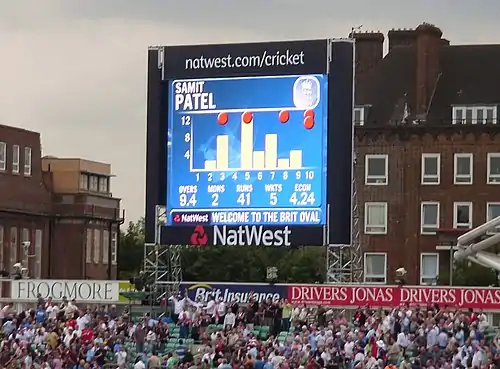Bowling analysis
In cricket, a bowling analysis (sometimes shortened to just analysis, especially in the phrase innings analysis, and also referred to as bowling figures) usually refers to a notation summarising a bowler's performance in terms of overs bowled, how many of those overs are maidens (i.e. with no runs conceded), total runs conceded and number of wickets taken.[1] Bowling analyses are generally given for each innings in cricket scoreboards printed in Wisden Cricketers' Almanack, newspapers and so on, but they are also sometimes quoted for other periods of time, such as a single spell of bowling. Typically, the analysis is given in the following format: Overs – Maidens – Runs conceded – Wickets.
.jpg.webp)
In some cases, overs and maidens are omitted from bowling figures, and are recorded showing 'Wickets/Runs'; for example, 7/15 by Glenn McGrath against Namibia shows he took his 7 wickets for 15 runs.[2]
Sometimes, in limited overs cricket, the 'maidens' figure is replaced by the number of dot balls bowled.
In Test cricket, the best bowling analysis for a single innings is 10/53 by Jim Laker.[3] The best bowling analysis in an ODI is 8/19 by Chaminda Vaas.[4] The best bowling analysis in a Twenty20 International is 6/7 by Deepak Chahar.[5] In first-class cricket, the best bowling analysis for a single innings is 10/10 by Hedley Verity.[6]
References
- "Definition: bowling analysis". Merriam-Webster. Encyclopædia Britannica. Retrieved 29 January 2012.
- "Key battles: Australia v England". BBC News. 1 March 2003. Retrieved 27 August 2013.
- "Records / Test matches / Bowling records / Best figures in an innings". ESPNcricinfo. Retrieved 27 August 2013.
- "Records / One-Day Internationals / Bowling records / Best figures in an innings". ESPNcricinfo. Retrieved 27 August 2013.
- "Records / Twenty20 Internationals / Bowling records / Best figures in an innings". ESPNcricinfo. Retrieved 21 June 2015.
- "Records | First-class matches | Bowling records | Best figures in an innings | ESPN Cricinfo". Cricinfo. Retrieved 2 March 2017.
